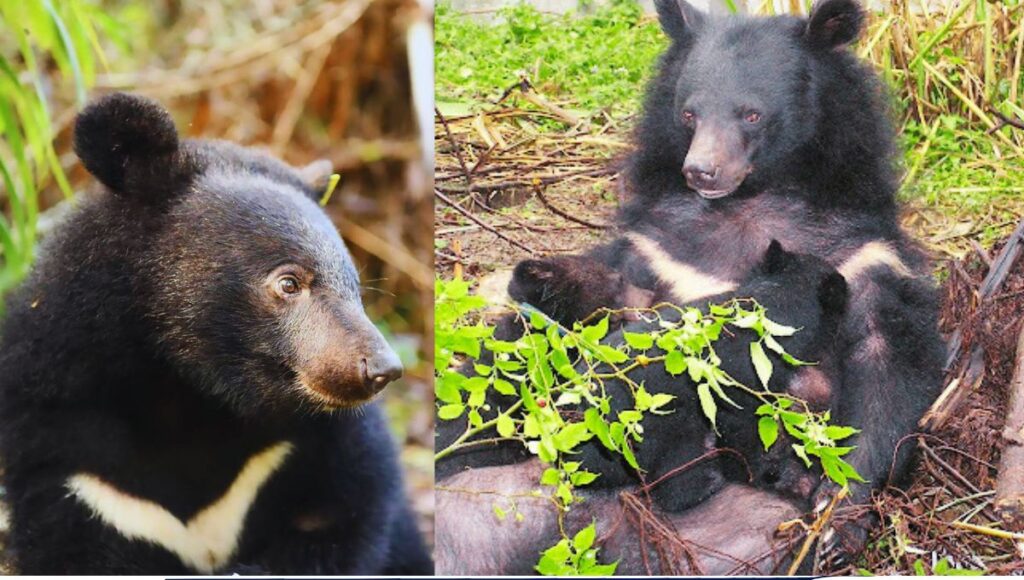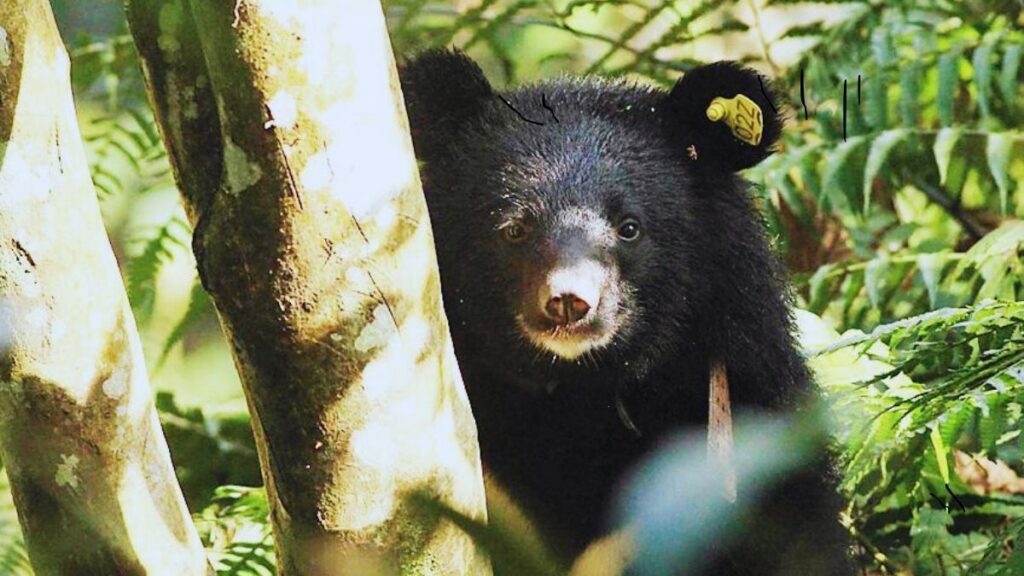Formosan Black Bear is a large Asian mammal and a sub-species of Asiatic Black Bear endemic to Taiwan. It is also known as a White-throated bear because of its white’ V’-shaped neck and chest marking. The species is also known as Dog Bear as they bark like a dog and have long muzzles similar to dogs. But unfortunately, the decreasing population of the bear is a big concern to its existence.

Table of Contents
Formosan Black Bear- In a Glimpse:
| Common Name | Formosan Black Bear |
| Scientific Name | Ursus thibetanus formosanus |
| Other Name | Moon Bear, Dog Bear |
| Group Name | Sleuth, Sloth |
| Adult Weight | 60-200 kg |
| Lifespan | 25-30 years |
| Distribution | Taiwan |
| Habitat | Mountain ranges at an elevation of 3000-10000 ft. |
| Behaviour | Nocturnal and Solitary |
| Speed | 35-40 Kmph |
| Diets | Omnivorous |
| Sexual Maturity (Male) | 4-5 Years |
| Sexual Maturity (Female) | 3-4 Years |
| Gestation Period | 6-7 months |
| Breeding Season | December- February. |
| Litter Size | 1-3 |
| Age of Independence | 2 Years |
| Predators | Snow leopards, Cloud leopards, and wolf packs |
| IUCN Status | Vulnerable |
| CITES | Appendix I |
Everything About Formosan Black Bear:
Scientific Classification:
| Domain: | Eukaryota |
| Kingdom: | Animalia |
| Phylum: | Chordata |
| Class: | Mammalia |
| Order: | Carnivora |
| Family: | Ursidae |
| Genus: | Ursus |
| Species: | Ursus thibetanus |
| Subspecies: | Ursus thibetanus formosanus |
Relatives:
| Common Name | Scientific Name | Distribution | IUCN Status |
| Balochistan Black Bear | Ursus thibetanus gedrosianus | South West Pakistan | Endangered |
| Japanese Black Bear | Ursus thibetanus japonicus | Japan | Vulnerable |
| Himalayan Black Bear | Ursus thibetanus laniger | Himalayas of India, Bhutan, Nepal, China, and Pakistan. | Vulnerable |
| Indo-Chinese Black Bear | Ursus thibetanus mupinensis | Southwestrn China and Szechuan | N/A |
| Tibetian Black Bear | Ursus thibetanus thibetanus | India, Myanmar, Nepal | Vulnerable |
| Ussuri Black Bear | Ursus thibetanus ussuricus | Korea and Siberia | N/A |
Physical Appearance:

The bear is heavily built with a round head, short neck, small eyes, and long snout. The bear’s snout is similar to the dog and hence it is also known as Dog-Bear. The body is covered with rough, glossy, black hairs which is more than 10 cm long around the neck. The tip of the chin is white.
There is a ‘V’-shaped or crescent-shaped moon on the chest, which is white or yellowish in colour. Thus it is also known as ‘Moon Bear’ or ‘White Throated Bear’.
Size:
The head measures around 26-35 cm in length and around 40-60 cm in circumference. The ears are 8-12 cm long. It is the largest mammals live in Taiwan weighing between 60 and 200 kg.
Lifespan:
The Formosan Black Bear lives around 25-30 years in the wild.
Range:
The bears are endemic to Taiwan, especially in the mountain ranges. It is found in central Taiwan and snow mountain ranges as well.
Habitat:
The bear prefers to live in mountain ranges at an elevation of 3000-10000 ft. In winter they move to lower elevations rather than hibernating.
Behavior:

Like other Asiatic Black Bears, the Formosan Black Bears are nocturnal in nature. During the day, they usually rest and digest food at caves or tree trunks. However, in spring and summer, they spend 50-60% of their daytime foraging. They mark their territory by scratching trees and urinating.
The bears are generally solitary in nature. They are found in pairs or in groups only in mating season. The nears are the only bear on the planet that forms temporary nests.
They look clumsy and slow but they can easily outrun humans with a speed of 35-40 kmph. They are excellent swimmers and climbers. They tend to avoid humans although they can be aggressive and harm humans. In an encounter, the bear retreats and runs away from humans.
Diets:
The bears are omnivorous in nature. They feed on leaves, buds, fruits, flowers, and small plants. However, they also consume insects, small animals, carrions etc. They prefer carbohydrate-rich food in summer and fat-loaded food in winter.
Reproduction:

Formosan Black Bears are primarily solitary animals without a fixed shelter. Only females have fixed shelter during breeding periods. The courtship period is very short and after mating they went to their solitary lives. At this time, the male tracks the female partner by the smell of her urination.
The female reaches sexual maturity at the age of 3-4 years while the male reaches 4-5 years of age. The pregnancy period lasts for 6-7 months. The mating is done between June and August and breeding takes place in December- February.
The litter size is usually 1-3 cubs. The mother nurtures her cubs for 6 months. Until the cubs are strong enough to leave the den, they remain with their mother. At the age of 2 years, the cubs become independent and leave the den. The reproductive cycle of the bear is 2 years.
Cultural Significance:
The Formosan Black Bear was voted as the most representative wildlife of Taiwan. The famous comic Winnie-the-Pooh contains the bear as a character. The bear also become the mascot of many events and it symbolizes Taiwanese identity. In 2021, the Taiwan Government made the species a Taiwan Tourism Mascot.
Threats:
- The major threats faced by the species are hunting and poaching. Bunun tribes call the bear ‘Aguman’ or ‘Duman’ which means devil.
- Habitat loss is another major threat faced by the bear.
Predators:
Snow leopards, Cloud leopards, and wolf packs are the major predators of the bear.
Conservation Status:
The species is listed as ‘Vulnerable’ in the IUCN Red List of Threatened Species and also listed in Appendix-I of CITES.
2 Best Places to Watch Formosan Black Bear:
- Yushan National Park is the core of the Formosan Black Bear population.
- You can also visit the Taipei Zoo to watch the bear.
Frequently Asked Questions (FAQs):
What does the Formosan Black Bear symbolize?
Formosan Black Bear is a symbol of Taiwanese identity. Previously, the bear was used as a mascot in various international events held by Taiwan.
Why is the Taiwan Black Bear endangered?
The number of Taiwanese black bears is constantly decreasing. There are a few reasons behind this:
1. The major threats faced by the species are hunting and poaching. Bunun tribes call the bear ‘Aguman’ or ‘Duman’ which means devil.
2. Habitat loss is another major threat faced by the bear.
Are Formosan Black Bears aggressive?
The bears can be aggressive. But during encounters with humans, they escape the place. The bears are peace-loving creatures. But according to the situation, they can be aggressive which doesn’t go with their personality.
How Many Formosan Black Bears are there?
According to research, there are only 300-600 Formosan Black Bears present in entire Taiwan. The number is constantly decreasing which poses a threat to their existence.
What is the size of the Taiwanese Black Bear?
The Taiwanese Black Bear is the largest mammal in Taiwan. The head measures around 26-35 cm in length and around 40-60 cm in circumference. The ears are 8-12 cm long. It is the largest mammals live in Taiwan weighing between 60 and 200 kg.
References: Wikipedia
Also Read: Formosan Rock Macaque: The Only Native Primate in Taiwan